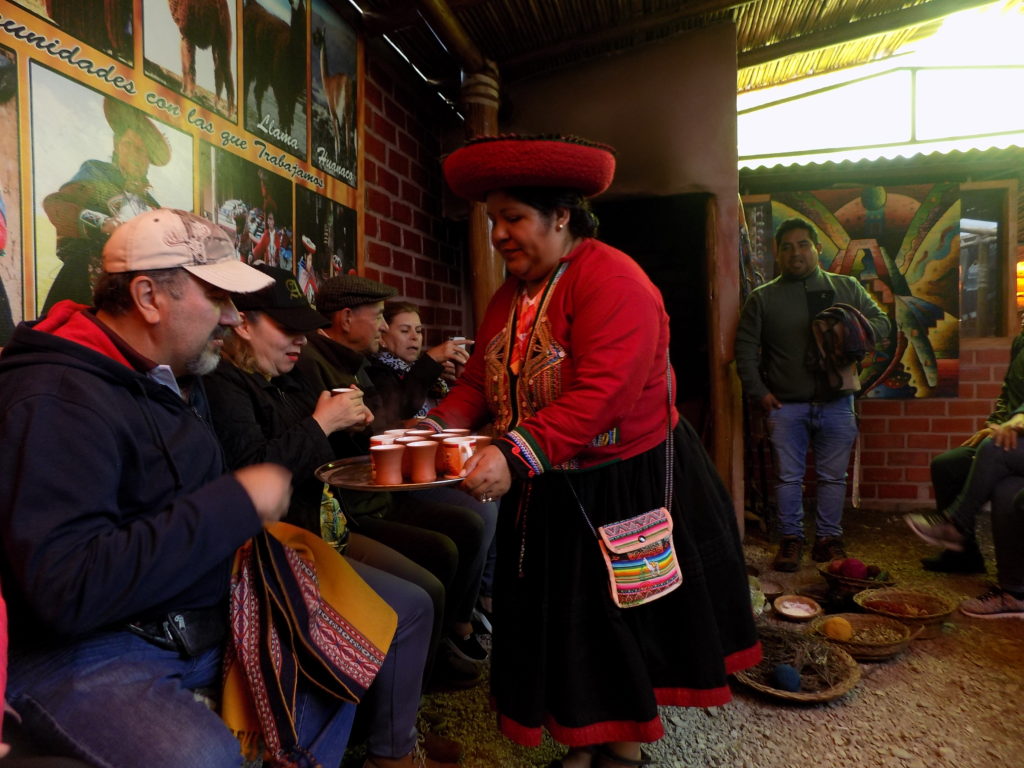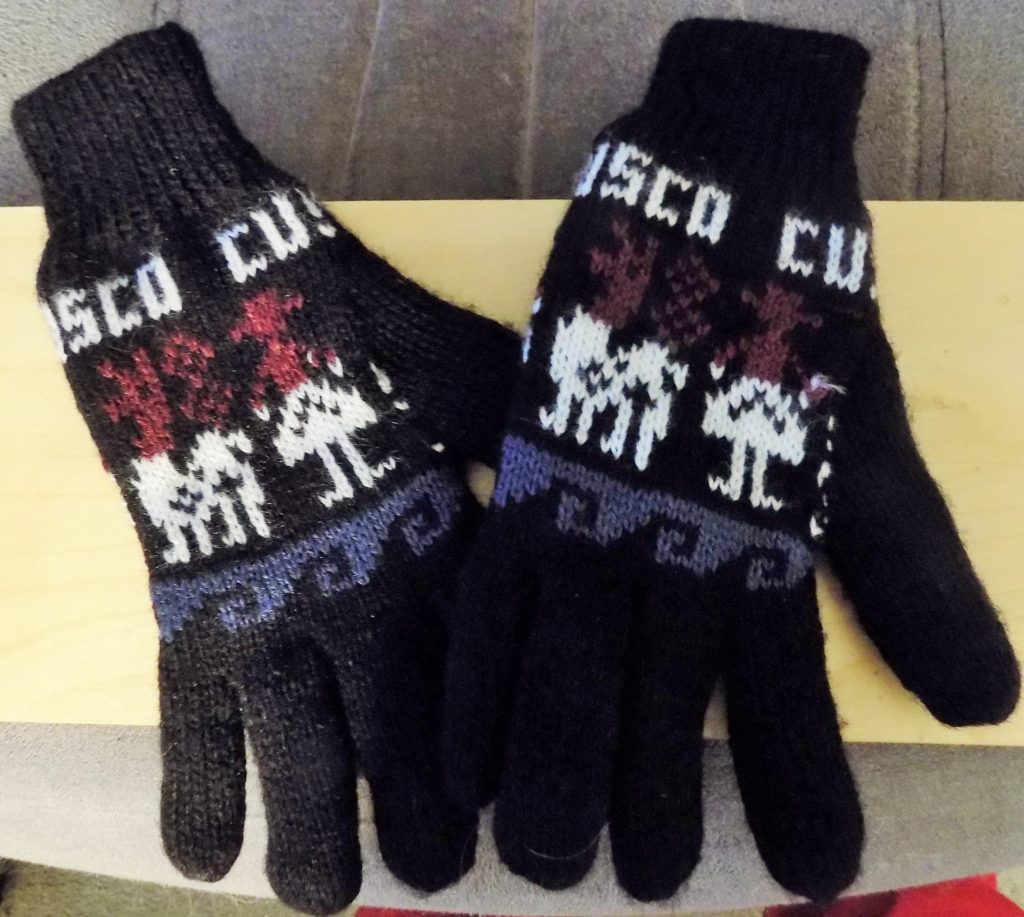In the first post about this adventure, I opined that one of the benefits of being in a group as small as ours was getting a high level of personal attention from the guide and at no time was that more apparent than yesterday when Berner walked with me to an optometrist’s shop to purchase those replacement glasses. I probably could have negotiated locating it on my own but his presence simply in finding the shop expedited and facilitated the transaction.
On the other hand, the tour we booked for today is an example of one of the possible drawbacks of having only three in the group – when unity is lacking, someone ends up on their own. Our options for this free day were to stay in Cusco and explore more of the city on our own or to book a tour to see three nearby sites of great interest – Chinchero, Moray, and Salineras de Maras. Jan chose the former while Jill and I opted for the latter.
Since the cost would have doubled had we tried to book an exclusive tour, Berner arranged for us to join a larger group but this, too, had a bit of a downside. First, the larger group was primarily Argentinian and we were the only English speakers. Though the guide was bilingual, I thought he was clearly more comfortable speaking Spanish and rightly wanted to pay more attention to the larger group. Second, at least a part of the group had visited the area near Chinchero which was our first stop so we didn’t see the town center or the nearby archaeological sites. (This isn’t entirely negative since, when we reached the end of the tour, I thought we’d had to rush through each of the three places although this might also have been related to the altitude and our reluctance to overly exert ourselves.)
While we were closer to acclimating to the altitude, (or perhaps still feeling the effects of last night’s dinner) we began the day still huffing and puffing a bit through our short 700-meter walk from the hotel to the Plaza Kusipata or Plaza El Regocijo.
We stood under the colonnades to avoid the intermittent light rain until the van arrived. Not too surprisingly, we left a few minutes behind schedule. The distance to our first stop was 30 kilometers north of Cusco and took about 45 minutes.
In addition to driving north, we were once again climbing up. The village of Chinchero – which the Inkas believed was the birthplace of the rainbow – sits at an altitude of 3,765 meters or roughly 365 meters higher than Cusco. I’ve read that on a clear day visitors have lovely views of both the Cordillera Vilcabamba, dominated by the mountain called Salkantay, to the west as well as the agricultural terraces dating from at least Inkan times that are still used today. Our day, as you can see, was far from clear.
(For the Incas, Salkantay was an Apu. Sometimes apu translates as lord or protector but in this instance its likely translation is god. The Incas had a number of mountain gods who controlled various aspects of their lives including the usefulness of wild plants and animals, the growth of domestic crops, and, of course, weather. The name itself looks to have been derived from sallqa meaning wild or untamed.┬Ā
Salkantay was viewed as one of the mountain gods controlling rain and thus fertility in the area we call the Sacred Valley. According to Archaeology magazine, Salkantay is viewed as male and one of the fathers of all the other mountains in the region. Additionally, it states, “the mountain is still invoked in rituals to cure illness.”)
The prominent feature of the town of Chinchero itself is the main square with an early 17th century adobe church and an Inkan stone wall with 10 trapezoidal niches. Most believe the wall remains from the time of Tupaq Inka Yupanqui the heir to Pachakutiq. It’s believed that Tupaq oversaw the construction of a network of aqueducts and terraces and that he might have used Chinchero as a second residence when he wanted to get away from Cusco.
Not with my bones you don’t.
The day was overcast so we didn’t have the mountain views and our tour didn’t include a stop in the main square (which requires an admission ticket). Instead, we proceeded directly to a demonstration of the craft for which Chinchero is most famous – traditional weaving. I’d read a little about Chinchero before this trip and because the town is known for this style of weaving and for its Sunday textile market, I was more comfortable in accepting the women clad in traditional garb as more authentic than I might otherwise have been and with less doubt than I’d had at Uros.
We began with a bit of hospitality in the form of a cup of mu├▒a tea.
(Mu├▒a is a member of the mint family that grows throughout the highlands between Puno and Cusco. Like coca tea, mu├▒a is reputed to have some palliative effects on altitude discomfort. Because it’s high in calcium, it’s also believed to have a salutary impact on teeth and bones as well as being an effective digestif.)
The weaving demonstration began with grating a root called saqta into a bowl to which our instructor (the woman in the photo above) added some hot water and whisked into a froth. She then grabbed a matted grayish hank of alpaca wool and immersed it in the soapy water. (Much like sheep, whose wool is sometimes used in other parts of the Andes, alpacas can get very dirty in their natural environment.) After a minute or two, the wool emerged clean, pure, and white. She showed us the water that had turned brown and dirty.
This, she explained, would not be the only time the wool is washed. In fact, the steps to reaching a final product are:┬Āshear, wash, dry, comb, spin, wash again, dye, rinse, ply, warp, and finally weave.
Next came a demonstration of the dyeing process. Like the soap, the dyes are mainly plant sourced. Ch’illqa yields green, awaypilly a light purple, mutuy for yellow, and so on. The one notable exception came from a cochineal – a bug that’s found on cactus plants and is used to make a deep red. The colors are fixed by the addition of some combination of salt, citric acid (usually from limes), a local mineral called qullpa, and sometimes a child’s urine. (For a reason I didn’t quite understand, the urine isn’t used after the child reaches puberty.)
Most of the weaving is done on a loom but sometimes they also use bones for finer work. When someone on the tour asked our hostess where the bones came from, she jokingly replied that they were the bones of the last tourist who didn’t buy something.
I believe in minimalist travel. Even for a trip as long as this one, I pack everything into a single carry on bag and have a small briefcase for my laptop, camera, and some other incidentals. This leaves me little room for souvenirs. I’m also at a stage in my life where I’m more inclined to divest myself of things than add them. But in this instance, ever the cautious man that I am, I found room for these.
We left in good spirits and with all our bones intact. Our next stop would be the curious Inkan ruins at Moray.


